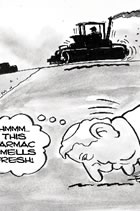
Robert Musumeci’s analysis of MEPA decisions Flagpoles on Europa BuildingA full development application was submitted to MEPA, proposing the fixing of two inclined flagpoles on the façade of Europa House fronting St Paul Street in Valletta. This building represents an imposing 18th century three-storey town house, having a strong presence, with its entrance façade facing onto the bustling life of the city and its back façade overlooking the calm grandeur of the Grand Harbour. This building is currently awaiting to be scheduled as a Grade 2 listed building. Indeed, Grade 2 buildings are structures of some architectural or historical interest or which contribute to the visual image of an Urban Conservation Area. Permission to demolish such buildings will not normally be given. However, alterations to the interior of Grade 2 buildings will be allowed if proposed to be carried out sensitively and causing the least detriment to the character and architectural homogeneity of the building. The whole of Valletta is designated as an Urban Conservation Area.  The building in question serves as offices of the European Commission and the European Parliament in Malta. According to historic documents, this house was occupied for about two centuries by the Pasquale Sceberras Trigona family, and therefore for much of its lifetime it has been a place of residence. The building in question serves as offices of the European Commission and the European Parliament in Malta. According to historic documents, this house was occupied for about two centuries by the Pasquale Sceberras Trigona family, and therefore for much of its lifetime it has been a place of residence. On assessing the application, the Directorate stated that the proposed development is not acceptable since these are considered as accretions which would alter the visual character of a potential Grade 2 building. In his argument, the case officer observed that flagpoles are not a traditional element within Maltese architecture. He went further to quote Part 14.1 of the Policy and Design Guidance for Shop Fronts, which states that projecting signs will not generally be allowed in UCAs and on listed buildings – against the same logic, the case officer argued that projecting flagpoles are equally objectionable. In his conclusion, the case officer argued that the proposed development is incompatible with the urban design and environmental characteristics of Valletta. The case officer also underlined that the proposed flagpoles would detract from the overall objectives of the Structure Plan for the preservation and enhancement of buildings and spaces. According to the same case officer, the proposal, if approved, would detract from the historical value of this important building in conflict with Structure Plan Policy UCO 7, which seeks to preserve buildings of outstanding architectural or historical interest in their entirety. In his line of defense, the architect simply stated that flagpoles are typically permitted on facades of historic buildings serving as state offices. When the case was referred to the DCC earlier this week, the proposal was approved in view of the particular use and status of the premises. This is yet another case example showing clearly that planning policies cannot be interpreted in a vacuum. Any comments? |
MT Surveys We asked.... Do you know what Vision 2015 is? 89% said ‘no’ Labour leads, but Gonzi makes slight recovery Survey confirms unpopularity of commuting Who’s the most trusted nanny in Gonzi’s cabinet? Consumers fishing around for better deals Robert Arrigo ‘most wanted’ for minister Cabinet thrives, but Fenech and Gatt hit rock bottom Bleak times – depression at the Grand Harbour Budget 2010 – Raise taxes or cut benefits? Only 35% will be taking a holiday this summer Corned beef? a matter of class Labour poised for absolute majority |
Managing editor Saviour Balzan | Tel. ++356 21382741 | Fax: ++356 21385075 | Email




